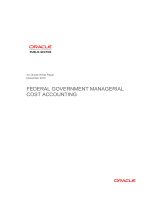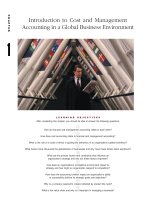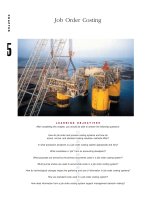Managerial and Cost Accounting Exercises II
Bạn đang xem bản rút gọn của tài liệu. Xem và tải ngay bản đầy đủ của tài liệu tại đây (1.43 MB, 20 trang )
Larry M. Walther; Christopher J. Skousen
Managerial and Cost Accounting
Exercises II
Download free books at
Download free eBooks at bookboon.com
2
Larry M. Walther & Christopher J. Skousen
Managerial and Cost Accounting
Exercises II
Download free eBooks at bookboon.com
3
Managerial and Cost Accounting Exercises II
1
st
edition
© 2011 Larry M. Walther & Christopher J. Skousen &
bookboon.com
All material in this publication is copyrighted, and the exclusive property of
Larry M. Walther or his licensors (all rights reserved).
ISBN 978-87-7681-796-1
Download free eBooks at bookboon.com
Click on the ad to read more
Managerial and Cost Accounting Exercises I
4
Contents
Contents
Problem 1 6
Worksheet 1 7
Solution 1 7
Problem 2 8
Worksheet 2 8
Solution 2 9
Problem 3 10
Worksheet 3 10
Solution 3 10
Problem 4 11
Worksheet 4 11
Solution 4 11
www.sylvania.com
We do not reinvent
the wheel we reinvent
light.
Fascinating lighting offers an infinite spectrum of
possibilities: Innovative technologies and new
markets provide both opportunities and challenges.
An environment in which your expertise is in high
demand. Enjoy the supportive working atmosphere
within our global group and benefit from international
career paths. Implement sustainable ideas in close
cooperation with other specialists and contribute to
influencing our future. Come and join us in reinventing
light every day.
Light is OSRAM
Download free eBooks at bookboon.com
Click on the ad to read more
Managerial and Cost Accounting Exercises I
5
Contents
Problem 5 13
Worksheet 5 13
Solution 5 14
Problem 6 16
Worksheet 6 17
Solution 6 17
Problem 7 19
Worksheet 7 19
Solution 7 20
360°
thinking
.
© Deloitte & Touche LLP and affiliated entities.
Discover the truth at www.deloitte.ca/careers
Download free eBooks at bookboon.com
Managerial and Cost Accounting Exercises I
6
Problem 1
Problem 1
Brian Snow is a river guide on the Columbia River. Typically brian takes tourists around 30 to 80 miles
upriver. Round trip takes anywhere from 2 to 8 hours before returning to dock. Brian has noted that
overall fuel costs vary based on “miles upriver” and he is considering changing his guide fee to separately
charge customers for estimated fuel costs. Below Brian’s log for 15 typical days showing “miles upriver”
and “total fuel cost”.
Day Miles Upriver Fuel Cost
1 55 $129
2 61 139
3 33 109
4 42 120
5 73 148
6 37 111
7 49 127
8 55 130
9 66 139
10 36 115
11 43 120
12 67 144
13 52 124
14 54 130
15 46 120
Total
$ 769 $ 1,905
a) Use the high-low method to determine the “xed fuel cost” associated with the trolling time,
and the “variable fuel cost” associated with running up and down the river.
b) If the sole objective of the fuel charge is to approximately recover actual costs incurred
each day, would “$2.50 per mile upriver” be a fair formula? What alternative formula might
you suggest?
Download free eBooks at bookboon.com
Managerial and Cost Accounting Exercises I
7
Problem 1
Worksheet 1
a)
MILES RUN COST
HIGH LOW
b)
Solution 1
a)
MILES RUN COST
Highest Level 73 $ 148.00
Lowest Level 33 109.00
Dierence
40 $ 39.00
Variable cost per mile upriver – ($39/40 miles): $0.975
HIGH LOW
Total Cost $ 148.00 $ 109.00
Less: Variable Cost ($0.963 per mile X miles upriver) 71.18 32.18
Fixed Cost
$ 76.83 $ 76.83
b) Although the idea of charging $2.50 per mile would seem to average out about right
($1,905/769 miles = $2.48), it would not be a fair day-by-day charge. Some days would be
overpriced (e.g., 75 miles @ $2.50 would recover $187.50 – more than the actual expected
cost), and other days would be underpriced (e.g., 30 miles @ $2.50 would recover only $75 –
far less than the actual expected cost). A simple and fair formula might be a $75 at fee (for
trolling time), plus $1.00 per mile upriver.
Download free eBooks at bookboon.com
Managerial and Cost Accounting Exercises I
8
Problem 2
Problem 2
Jakob Loos recently graduated from medical school. He is considering opening his own family practice
doctor oce. A doctor’s oce is a high-xed cost business, as it requires considerable expenditures for
facilities, labor, and equipment, no matter how many families are served. Assume the annual xed cost
of operations is $400,000. Further assume that the only signicant variable cost relates to patients served.
An average patient served costs $250. Jakob’s banker has asked a variety of questions in contemplation
of providing a loan for this business.
a) If the average family is charged $475 for services, how many families must be served to clear
the break-even point?
b) If the banker believes Jakob will only serve 1,000 families during the rst year in business,
how much will the business lose during its rst year of operation?
c) If Jakob believes his prots will be at least $100,000 during the rst year, how much is he
anticipating for total revenue?
d) e banker has suggested that Jakob can reduce his xed costs by $100,000 if he will not
purchase certain equipment. Jakob can instead lease or rent this equipment as needed. e
variable cost of leasing this equipment is $55 per family served. Will this suggestion help
Jakob reach the break-even point sooner?
Worksheet 2
a) Break-Even Point in Patients =
b)
c) Sales for a Target Income =
d) New Break-Even Point in Patients =









